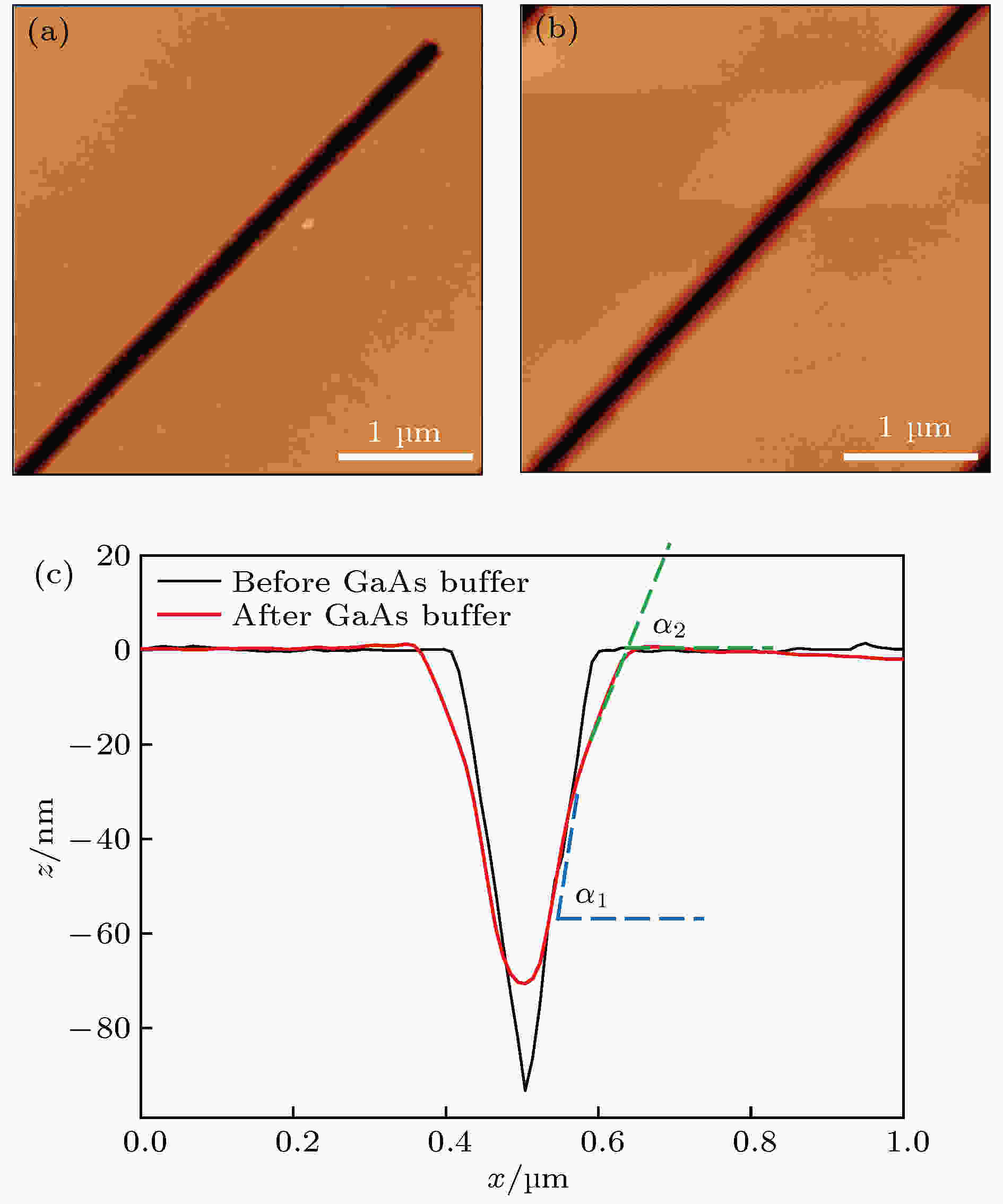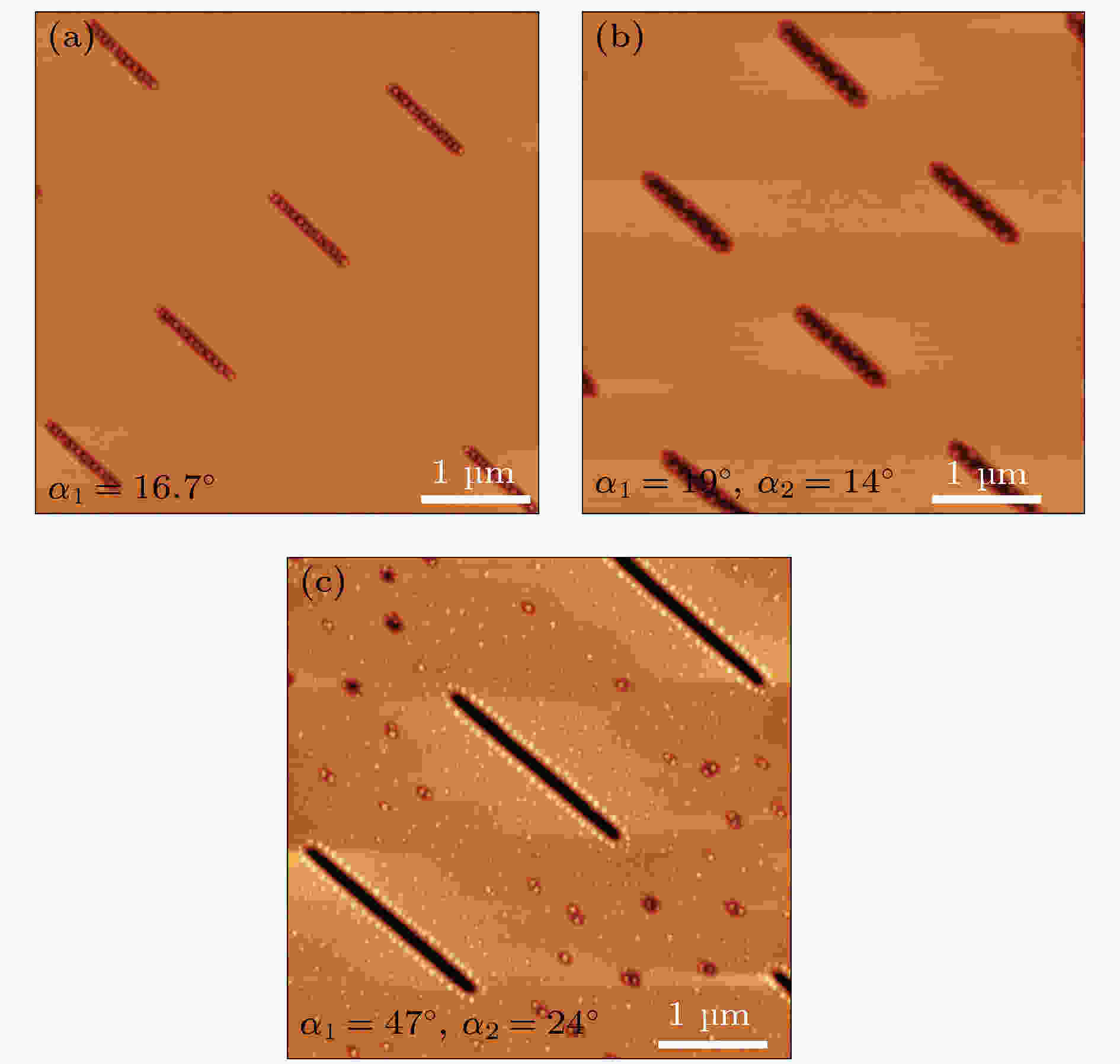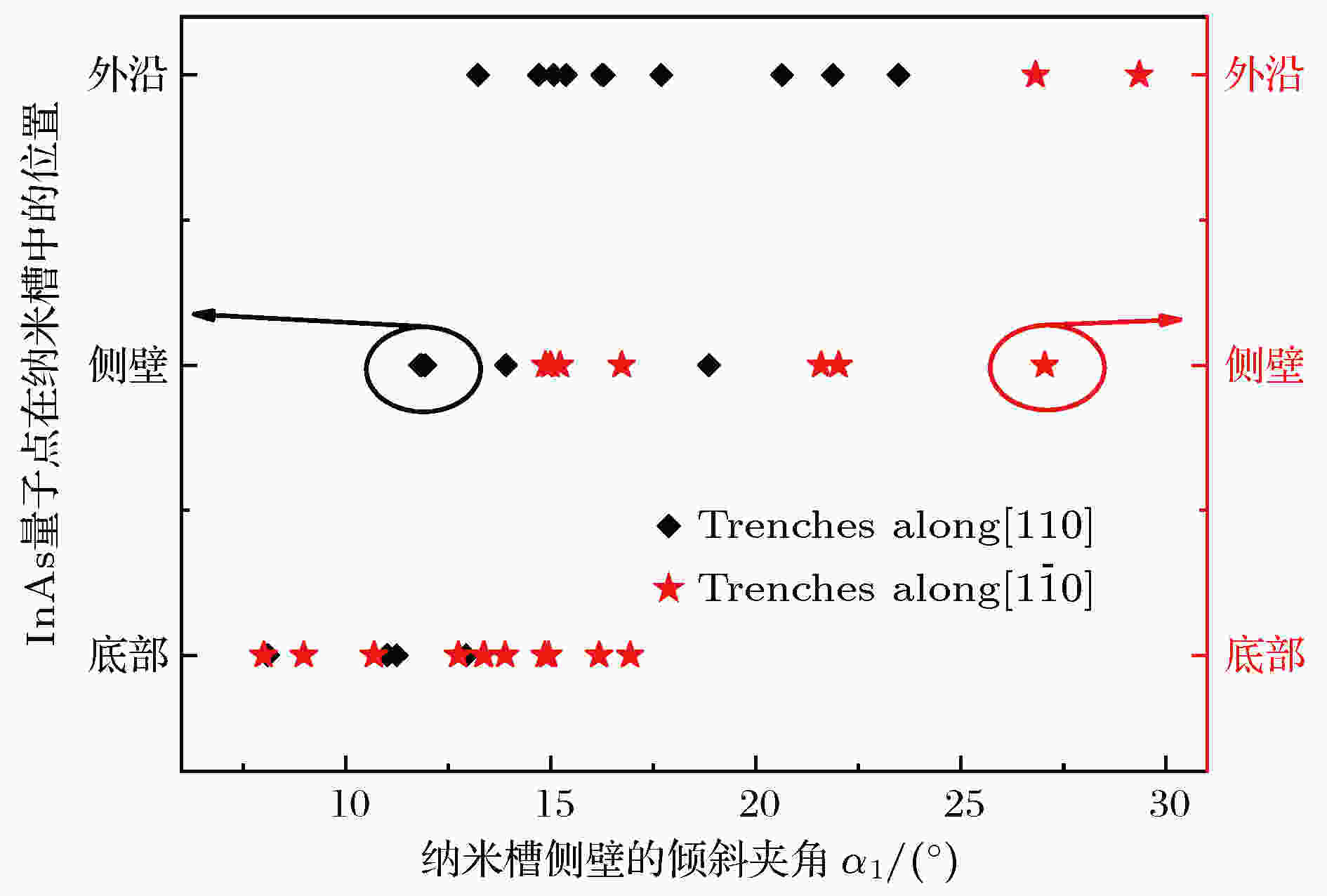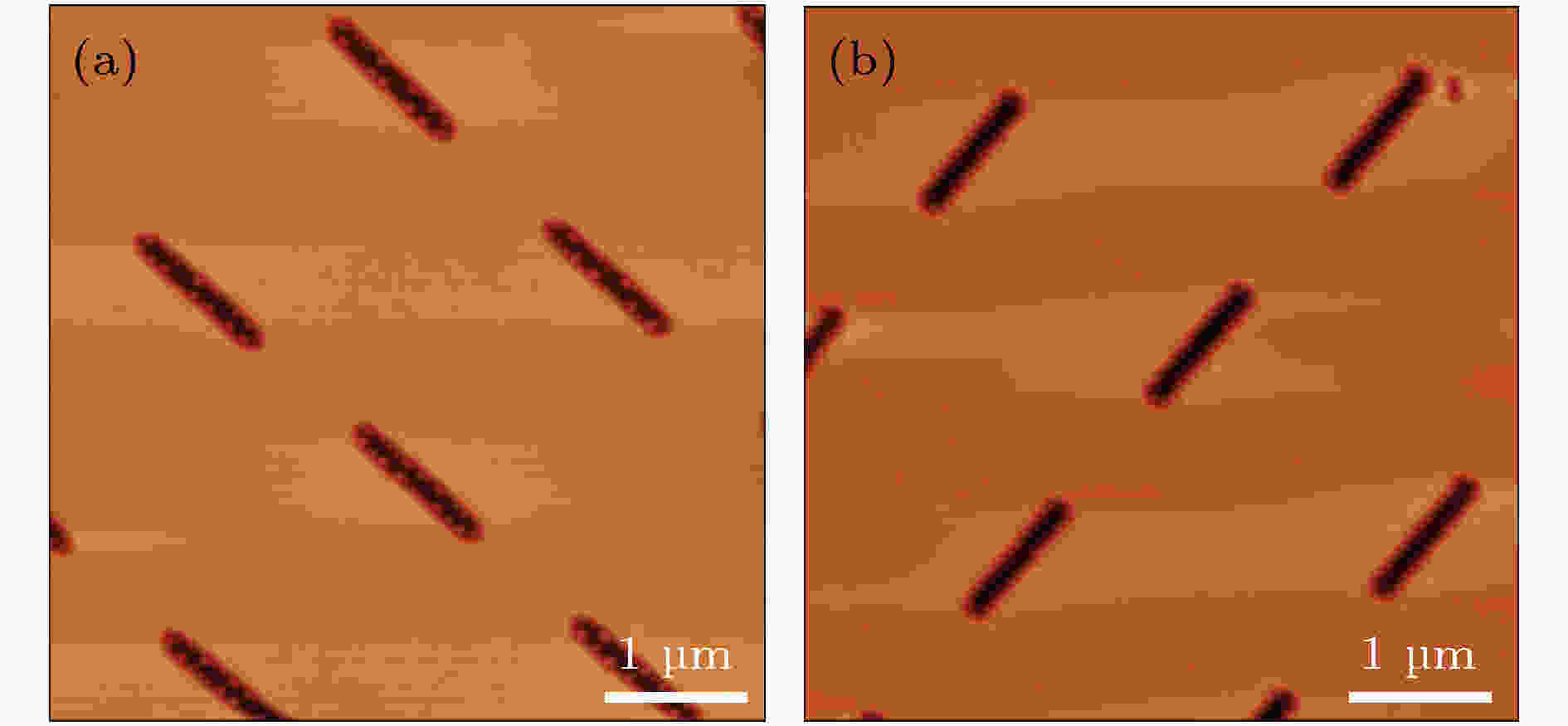摘要: InAs/GaAs量子点是重要的单光子源, 位置可控量子点对实现可寻址易集成的高性能量子点光源具有重要意义. 本文详细研究了氢原子条件下GaAs (001)图形衬底的低温脱氧过程, 低温GaAs缓冲层生长中沟槽形貌的演化过程, 以及沟槽形貌对量子点形核位置的影响. 发现GaAs衬底上纳米沟槽侧壁的倾斜角较小时, InAs量子点会优先生长于沟槽底部; 当沟槽的侧壁倾斜角较大时, InAs量子点则会优先生长于沟槽两侧的外边沿位置. 此外, 本文还研究了纳米孔洞侧壁的倾斜角对量子点成核位置的影响, 实现了双量子点分子和四量子点分子的定位生长.
关键词: InAs 量子点 /
图形衬底 /
成核位置 /
定位生长 English Abstract Controllable growth of InAs quantum dots on patterned GaAs (001) substrate Wang Hai-Ling 1,2 ,Wang Ting 1 ,Zhang Jian-Jun 1 1.Nanoscale Physics and Devices Laboratory, Institute of Physics, Chinese Academy of Sciences, Beijing 100190, China Fund Project: Project supported by the National Key Research and Development Program of China (Grant Nos. 2016YFA0301700, 2015CB932400) and the National Natural Science Foundation of China (Grant Nos. 11574356, 11434010).Received Date: 06 March 2019Accepted Date: 28 March 2019Available Online: 01 June 2019Published Online: 05 June 2019Abstract: InAs/GaAs quantum dot (QD) is one of the promising material systems for the quantum information processing due to their atomic-like optical and electrical properties. There are many previous researches reporting the InAs QDs which can be implemented as solid-state single-photon sources for quantum information and quantum computing. However, the site-controlled growth of QDs is the prerequisite for addressability and integration. There are very few researches focusing on the systematic study of preferential nucleation of InAs QDs on a patterned GaAs (001) substrate. In this work, we study the preferential nucleation sites of InAs QDs on a patterned GaAs (001) substrate with different trench sidewall inclinations. With small inclination angle of the trench sidewalls, the InAs QDs nucleate preferentially inside the trenches, while with large inclination angle, the edges of the trenches appear to be the preferential nucleation sites. By utilizing the established method, a pair of InAs dots can be uniformly achieved in the patterned pits through tuning the inclination angle of the pits. The site-controlled single InAs QD and InAs QD molecules on the patterned substrates could have potential applications in quantum information processing and quantum computing.Keywords: InAs quantum dots /patterned substrate /nucleation site /site-controlled growth 全文HTML --> --> --> 1.引 言 InAs/GaAs自组装量子点(quantum dots, QDs)由于其优异的光电性质, 自发现以来从材料生长到器件应用都得到了广泛研究, 其中包括半导体激光器[1 ,2 ] 、近红外探测器[3 ,4 ] 、太阳能电池[5 ,6 ] 和单光子光源[7 ,8 ] 等. 另外随着量子信息技术[9 -11 ] 的发展, InAs量子点分子具有潜在的应用价值, 可用于制作量子原胞自动机[12 ,13 ] 等器件. 量子点的定位生长是量子点寻址和集成的前提, 因此实现定位生长InAs/GaAs单量子点、双量子点以及其他量子点分子组合具有重要的研究意义. 在以往的研究中, 最常见的制备方法是结合自上而下与自下而上的工艺步骤, 即电子束曝光和外延定位再生长的方法[14 ,15 ] , 首先在GaAs衬底上加工制备纳米结构(如纳米孔洞), 然后通过分子束外延(molecular beam epitaxy, MBE)在纳米结构中定位生长InAs量子点. 然而鲜有关于InAs量子点优先成核位置的研究, 只能在Si/Ge体系中找到类似的实验和理论计算[16 ,17 ] ,因此研究纳米图形结构影响InAs量子点优先成核位置的条件是必要的, 它对实现不同量子点分子结构的定位生长具有重要意义.2.实验过程 22.1.衬底制备、清洁和脱氧过程 2.1.衬底制备、清洁和脱氧过程 实验中使用的衬底是由wafe-tech公司提供的n型掺杂直径为3 in (1 in = 2.54 cm) 的GaAs (001)晶圆片. 图形衬底制备过程分为涂胶、前烘、曝光、显影、刻蚀五大步骤. 选用分子量为495的聚甲基丙烯酸甲酯 (poly methyl methacrylate,PMMA)作为抗蚀剂, 旋涂条件为4000 r/min, 旋涂厚度大约为90 nm, 前烘温度180 ℃, 烘烤时间为1 min. 然后快速将涂有光刻胶的平衬底进行曝光, 曝光过程使用Raith 150型号的电子束光刻(electron beam lithography, EBL)设备完成, 为提高精细结构在光刻过程中的精确度, 具体曝光参数为: 电子束加速电压20 kV, 透镜光阑孔径10 μm, 曝光剂量100 mJ/cm2 , EBL写场大小为100 μm × 100 μm. 显影定影过程为标准的PMMA光刻胶的显影定影工艺. 图形的转移是利用硫酸、双氧水和水的混合溶液(H2 SO4 ∶ H2 O2 ∶ H2 O体积比为3∶1∶640, 其中浓硫酸质量分数为98%, 双氧水质量分数为30%)对样品进行刻蚀. 通过调控硫酸、双氧水与水的比例及刻蚀时间, 可以实现纳米沟槽的侧壁倾斜角α 1 从5°到50°以及纳米沟槽深度10—60 nm的变化, 其中α 1 的定义如图1(d) 中所示, 即侧壁的延长线与衬底水平面的夹角, α 1 越大, 纳米沟槽侧壁越陡, α 1 越小, 侧壁越平缓.图 1 GaAs (001)衬底与沿$\left[ {1\bar 10} \right]$ 方向的纳米沟槽脱氧前后的形貌变化 (a)脱氧后平衬底区域的AFM图; (b), (c) α 1 ≈ 16°时图形结构区域脱氧前后的AFM图; (d)沟槽脱氧前后AFM线扫描图Figure1. Morphological change of patterned GaAs (001) substrate before and after deoxidation: (a) AFM image of flat GaAs after deoxidation; AFM image of patterned GaAs before (b) and after deoxidation (c), the trenches are orientated along $\left[ {1\bar 10} \right]$ direction and the sidewall inclination angle α 1 is about 16°; (d) AFM line-scans of the trenches before (black line) and after deoxidation (red line).2 O = 1∶3 (其中盐酸的质量分数为37%)溶液刻蚀GaAs表面的自然氧化层, 刻蚀时间为1 min, 随后迅速用去离子水冲洗1 min, 并用干燥的氮气吹干. 湿法去除氧化层后的样品需尽快放进MBE进样腔体中以免再次氧化. 进腔之后, 由于高温脱氧过程会对图形结构形貌产生影响[18 ] , 因此选用氢原子辅助脱氧, 具体过程为: 将衬底温度升至350 ℃, 除气0.5 h, 同时将氢气裂解器温度升至1600 ℃, 打开氢气, 控制处理腔体的真空在1.0 × 10–7 —1.5 × 10–7 mbar (1 mbar = 100 Pa)范围, 样品在氢原子的环境中保持30 min. 经过这两步处理后的样品表面可以最大程度除去图形衬底上的氧化层.2.2.MBE生长过程 -->2.2.MBE生长过程 生长过程主要分为三步: 第一步为除气脱氢过程, 样品经过脱氧后, 传入III-V族MBE生长腔体, 将衬底温度升至500 ℃, 同时将As源打开, 并控制腔体真空在1.0 × 10–7 mbar附近, 使衬底处于As充分的气氛中退火10 min, 对样品除气和使表面氢原子脱附; 第二步为同质外延低温生长GaAs缓冲层, 将衬底温度降至420 ℃, 先沉积1个原子层(mono-layer, ML)的Ga原子[19 ,20 ] , 作为生长预置层, 然后打开As源, 且控制As/Ga 的束流比不超过10, 以0.5 ?/s的速率生长30 nm的GaAs薄膜, 反射式高能电子衍射(reflection high energy electron diffraction, RHEED)可原位观察到清晰的2 × 4表面重构; 第三步为异质外延生长InAs量子点, 将衬底温度升至500 ℃, 以0.1 ?/s的速率沉积2 ML的InAs, 此时RHEED图像由2 × 4的线状表面重构演变成点状图像.3.实验结果分析 经过氢原子环境中脱氧的GaAs图形衬底, 从腔体中取出, 使用大气环境下的原子力显微镜 (atomic force microscope, AFM)对其表面形貌进行表征, 结果如图1 所示. 图1(a) 为图形衬底平坦处5 μm × 5 μm区域的形貌图, 可以看出表面非常平整, 表面起伏在 ± 1 nm以内, RMS为0.168 nm, 生长过程中RHEED可以看到清晰的2 × 4表面重构. 图1(b) 和图1(c) 为小倾斜角纳米沟槽经过脱氧前后的AFM形貌图, 对比两图可以发现图形形貌未发生明显变化. 图1(d) 为图形结构脱氧前后的AFM线扫描对比图, 可发现纳米沟槽的宽度基本未发生变化, 只是深度略变深, 即α 1 由脱氧前约16°变成18°. 经过腔外和腔内两步脱氧过程, 在平衬底区域得到了非常平整的GaAs表面, 同时纳米沟槽的形貌基本保持不变, 在下文的实验分析中忽略了侧壁的变化.[18 ,21 ] , 为尽量降低其影响, GaAs缓冲层选用低温外延的方法. 外延前后的图形结构形貌如图2 所示, 图2(a) 中为外延生长前沿$\left[ {1\bar 10} \right]$ 方向纳米沟槽的AFM图, 图2(b) 是外延生长30 nm GaAs缓冲层后的AFM图, 图2(c) 是生长前后纳米沟槽的AFM线扫描图, 对比两条曲线可以看出, 纳米沟槽在经过低温外延30 nm GaAs后深度变浅, 宽度变宽. 对侧壁倾斜角进行分析, 底部倾斜角α 1 未发生明显变化, 但在沟槽边缘位置出现一个倾斜角α 2 ≈ 19°(α 2 的定义见图2(c) )的(114)稳定晶面. 也就是说低温生长30 nm GaAs缓冲层后, 底部倾斜角α 1 变化不大, 但沟槽边缘位置会出现一个侧壁倾斜角比α 1 小的(114)晶面, 进一步的实验显示这种现象在α 1 越大时越明显, 而当α 1 较小时, 这个晶面非常小.图 2 沿$\left[ {1\bar 10} \right]$ 方向倾斜角α 1 ≈ 40°时的纳米沟槽在GaAs缓冲层生长前后的形貌变化 (a), (b)低温外延30 nm GaAs缓冲层前后的AFM图; (c)生长前后沟槽的AFM线扫描图, 图中黑色曲线对应α 1 ≈ 40°, 红色曲线对应α 1 ≈ 39°, α 2 ≈ 19°Figure2. Morphological change of the trenches (inclination angle α1 ≈ 40° and orientated along $\left[ {1\bar 10} \right]$ direction) after GaAs buffer growth: (a), (b) AFM images of the trenches before and after the deposition of 30 nm GaAs buffer at low temperature; (c) the black and red lines represent the cross-sectional AFM line-scans of (a) and (b). α 1 ≈ 40° (black line); α 1 ≈ 39°, α 2 ≈ 19° (red line).图3 所示. 图3(a) 中倾斜角度α 1 ≈ 16.7°, 量子点优先生长在纳米沟槽的底部, 在纳米沟槽底部形成了一条量子点链; 如图3(b) 所示, 沟槽的倾斜角α 1 ≈ 19°时, 量子点优先成核在纳米沟槽的内侧壁两侧; 图3(c) 中的纳米沟槽倾斜角α 1 ≈ 47°, 量子点均匀排布在纳米沟槽的外沿, 形成两条量子点链. 即InAs量子点在纳米沟槽中优先成核的位置, 会受到纳米沟槽侧壁的倾斜角α 1 的影响.图 3 沿$\left[ {1\bar 10} \right]$ 方向的纳米沟槽中InAs量子点优先成核位置分布图Figure3. Site-controlled growth of InAs QDs on patterned GaAs with trenches along $\left[ {1\bar 10} \right]$ direction.α 1 对InAs量子点优先生长位置的影响, 且考虑到GaAs (001)衬底沿[110]和$\left[ {1\bar 10} \right]$ 两个方向的各向异性, 统计对比了InAs量子点在[110]和$\left[ {1\bar 10} \right]$ 两个方向上的纳米沟槽中的生长位置与其倾斜角α 1 之间的关系, 如图4 所示. 从图中可以看出, 纳米沟槽侧壁的倾斜角α 1 的大小发生变化时, 量子点优先成核位置会明显变化, 图中黑色菱形和红色星形分别表示了沿[110]和$\left[ {1\bar 10} \right]$ 方向不同α 1 条件下纳米沟槽中量子点位置的分布. 沿$\left[ {1\bar 10} \right]$ 方向的纳米沟槽, 当其侧壁倾斜角α 1 ≤ 15°时, InAs量子点均优先生长于沟槽底部, 当α 1 ≥ 27°时, InAs量子点优先分布于沟槽的外沿. 沿[110]方向的纳米沟槽具有同样的趋势, 当α 1 ≤ 10°时, InAs量子点均优先生长于沟槽底部, 当α 1 ≥ 15°时, InAs量子点会优先生长于纳米沟槽的外沿. 也就是说InAs量子点在GaAs (001)图形化衬底纳米沟槽中生长时, 其优先成核位置遵循一个规律: 当纳米沟槽的侧壁平缓时, 量子点会优先生长在纳米槽底部, 反之, 侧壁变陡时, 量子点优先成核位置会向纳米沟槽侧壁和外沿转移. 在Ge/Si量子点体系中, 人们观测到了类似的实验现象, 理论计算显示锗量子点在硅孔洞衬底上优先形核位置的主要驱动力是弹性能的弛豫[16 ] . InAs/GaAs和Ge/Si量子点是高度相似的异质外延系统[22 ] , 因此, 我们可以定性理解InAs/GaAs量子点的优先形核位置也始终遵循弹性能最低的原则. 当沟槽侧壁的倾斜角较小时(沿$\left[ {1\bar 10} \right]$ 方向, α 1 ≤ 15°; 沿[110]方向, α 1 ≤ 10°), InAs量子点在纳米沟槽底部的弹性弛豫更容易, 其弹性能相对于纳米沟槽外的平坦区域更低, 因此InAs量子点会优先在纳米沟槽底部生长; 当纳米沟槽侧壁的倾斜角大于阈值角度时(沿$\left[ {1\bar 10} \right]$ 方向, α 1 ≥ 27°; 沿[110]方向, α 1 ≥ 15°), InAs量子点生长在沟槽底部的弹性能随角度变大显著增加, 并超过平坦位置上量子点的弹性能, 而沟槽外沿处量子点的弹性能随倾斜角的增大而降低, 因此此时沟槽外沿处的弹性能更低, 成为量子点形核的优先位置, 从而会出现在纳米沟槽外沿形成量子点链的现象. 当倾斜角角度适中时, 沟槽侧壁位置更有利于释放弹性能, 因此量子点会优先在侧壁处形核.图 4 InAs量子点在GaAs纳米沟槽中优先成核位置与纳米沟槽侧壁倾斜角α 1 的关系Figure4. Dependence of preferential nucleation site of InAs QDs on trench inclination angle of the patterned GaAs.α 1 的关系具有相似的规律, 但由于GaAs沿[110]和$\left[ {1\bar 10} \right]$ 两个方向具有各向异性, 使得量子点生长在[110]和$\left[ {1\bar 10} \right]$ 两个方向沟槽相同位置时所对应的α 1 的范围大大不同, 即沿[110]方向的沟槽所需要的侧壁倾斜角α 1 比沿$\left[ {1\bar 10} \right]$ 方向的小. 如图4 中当沿$\left[ {1\bar 10} \right]$ 方向纳米沟槽的侧壁倾斜角α 1 ≈ 15°时, 量子点会优先生长在沟槽底部, 而沿[110]方向的纳米沟槽的侧壁倾斜角α 1 则需要小于10°时, 量子点才会同样出现在沟槽底部. 同时, 图5 中展示了两个倾斜角度α 1 约为18°的不同方向纳米沟槽, 经过相同条件外延生长InAs量子点后, 沿$\left[ {1\bar 10} \right]$ 方向的纳米沟槽中的量子点生长在纳米沟槽的内壁, 而沿[110]方向的量子点生长在纳米沟槽的外边缘. 我们推测相同倾斜角条件下, InAs/GaAs量子点在两个相互垂直方向的纳米沟槽中优先生长位置不同的主要原因是In原子在GaAs纳米沟槽沿[110]和$\left[ {1\bar 10} \right]$ 方向侧壁的迁移和吸附能力不同. 有文献提到在GaAs(001)图形衬底上, 相较于(111) A 面, In原子在生长过程中优先吸附于(111) B 面[18 ] . 另外, 在外延生长过程中In原子会类似于Ga原子由(001)面往(111) B 面迁移和由(111) A 面往(001)面迁移[23 ,24 ] , 导致沉积InAs的量会在不同方向的纳米沟槽中重新分布. 那么当沿两个方向的纳米沟槽的侧壁夹角α 1 均约为18°, 量子点生长于槽内时弹性能相近时, 由于In原子会更加优先迁移并吸附于沿$\left[ {1\bar 10} \right]$ 方向的纳米沟槽侧壁晶面B 面, 导致量子点优先成核于槽内壁, 反之沿[110]方向则会出现In原子往纳米沟槽外迁移的现象, 因此量子点优先生长于纳米沟槽外沿.图 5 InAs QDs优先成核位置在相同倾斜角度不同方向的纳米沟槽中的各向异性 (a)和(b)分别为α 1 ≈18°时沿 $\left[ {1\bar 10} \right]$ 和[110]方向纳米沟槽生长InAs量子点后的AFM图Figure5. Orientational dependence of InAs QDs on trench-patterned GaAs along $\left[ {1\bar 10} \right]$ and [110]: (a) and (b) AFM images of InAs QDs grown on trench-patterned GaAs along $\left[ {1\bar 10} \right]$ and [110] with a trench inclination angle α 1 ≈ 18°.α 1 的规律, 制备了一系列不同侧壁倾角的纳米孔洞, 经过相同的生长条件, 在纳米孔洞中实现了双量子点分子(如图6(a) ), 在纳米孔洞侧壁实现了四量子点分子(如图6(b) ), 在纳米孔洞外沿实现了多量子点环(如图6(c) ). 图6(d) 是三种纳米孔洞的AFM线扫描曲线, 虚线表示的是纳米沟槽侧壁, 蓝色虚线对应的是图6(a) 中的纳米孔洞, 其倾斜角α 1 ≈ 10°, 小于量子点优先生长在沟槽底部的临界值, InAs量子点生长于纳米孔洞底部时弹性能最低, 同时纳米孔洞尺寸的限制作用使量子点于纳米孔洞内形成双量子点结构; 橘色虚线为图6(c) 中纳米孔洞侧壁的示意图, 其夹角α 1 ≈ 28°大于InAs量子点生长于纳米沟槽外沿的临界角度, 此时量子点生长于孔洞外沿的能量最低, 形成围绕纳米孔洞周围的量子点环; 绿色虚线为图6(b) 中纳米孔洞侧壁的示意图, 计算其倾斜角α 1 ≈ 17°, 夹角大小位于InAs量子点生长于纳米沟槽内壁和外沿的临界角附近, InAs量子点同时出现在内壁和孔洞外沿, 且由于纳米孔洞尺寸的限制, 在槽内形成了四量子点的结构. 因此实验显示通过控制纳米孔洞侧壁的倾斜角度α 1 , 可以实现不同组合的InAs量子点在GaAs图形化的纳米孔洞中不同位置的定位生长.图 6 调控纳米孔洞侧壁的倾斜角α 1 实现不同InAs量子点组合的定位生长 (a)生长在纳米孔洞底部的双量子点分子; (b)生长在纳米沟槽侧壁上的四量子点, 其中插图示意四量子点的位置; (c)纳米孔洞外沿形成量子点环; (d)图(a), (b)和(c)中纳米孔洞的AFM线扫描图, 倾斜角分别为10°, 17°, 28°Figure6. Site-controlled growth of InAs QDs molecules on pit-patterned GaAs (001) substrate: (a) Double InAs QDs molecules at the pits bottom; (b) four InAs QDs molecules in the pits; (c) QDs rings around the pits; (d) cross-sectional AFM line-scan of these pits. The inclination angles are 10°, 17°, 28°, respectively.4.结 论 详细研究了GaAs图形化衬底上MBE生长InAs量子点的生长过程, 包括衬底清洗、低温脱氧以及低温外延GaAs缓冲层对图形结构的影响. 发现沟槽侧壁的倾斜角对量子点的优先成核位置具有关键影响, 当沟槽侧壁的斜率较小时, 量子点会优先生长在沟槽底部, 当侧壁的斜率大于一定数值后, 量子点的优先成核点会变成纳米沟槽的外沿. 进一步调控纳米孔洞的侧壁倾角, 实现了InAs量子点分子在纳米孔洞中不同组合的定位生长.  图 1 GaAs (001)衬底与沿
图 1 GaAs (001)衬底与沿


 图 2 沿
图 2 沿

 图 3 沿
图 3 沿





































 图 4 InAs量子点在GaAs纳米沟槽中优先成核位置与纳米沟槽侧壁倾斜角α1的关系
图 4 InAs量子点在GaAs纳米沟槽中优先成核位置与纳米沟槽侧壁倾斜角α1的关系
















































 图 5 InAs QDs优先成核位置在相同倾斜角度不同方向的纳米沟槽中的各向异性 (a)和(b)分别为α1≈18°时沿
图 5 InAs QDs优先成核位置在相同倾斜角度不同方向的纳米沟槽中的各向异性 (a)和(b)分别为α1≈18°时沿 




 图 6 调控纳米孔洞侧壁的倾斜角α1实现不同InAs量子点组合的定位生长 (a)生长在纳米孔洞底部的双量子点分子; (b)生长在纳米沟槽侧壁上的四量子点, 其中插图示意四量子点的位置; (c)纳米孔洞外沿形成量子点环; (d)图(a), (b)和(c)中纳米孔洞的AFM线扫描图, 倾斜角分别为10°, 17°, 28°
图 6 调控纳米孔洞侧壁的倾斜角α1实现不同InAs量子点组合的定位生长 (a)生长在纳米孔洞底部的双量子点分子; (b)生长在纳米沟槽侧壁上的四量子点, 其中插图示意四量子点的位置; (c)纳米孔洞外沿形成量子点环; (d)图(a), (b)和(c)中纳米孔洞的AFM线扫描图, 倾斜角分别为10°, 17°, 28°